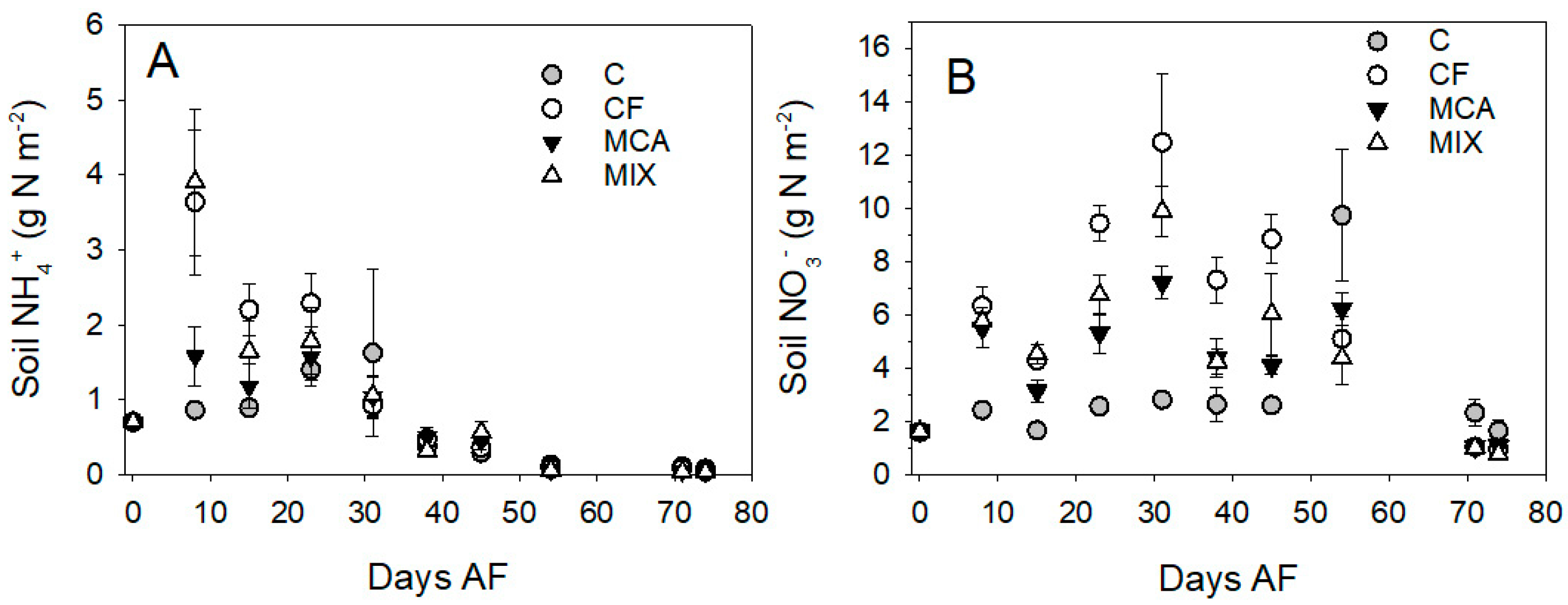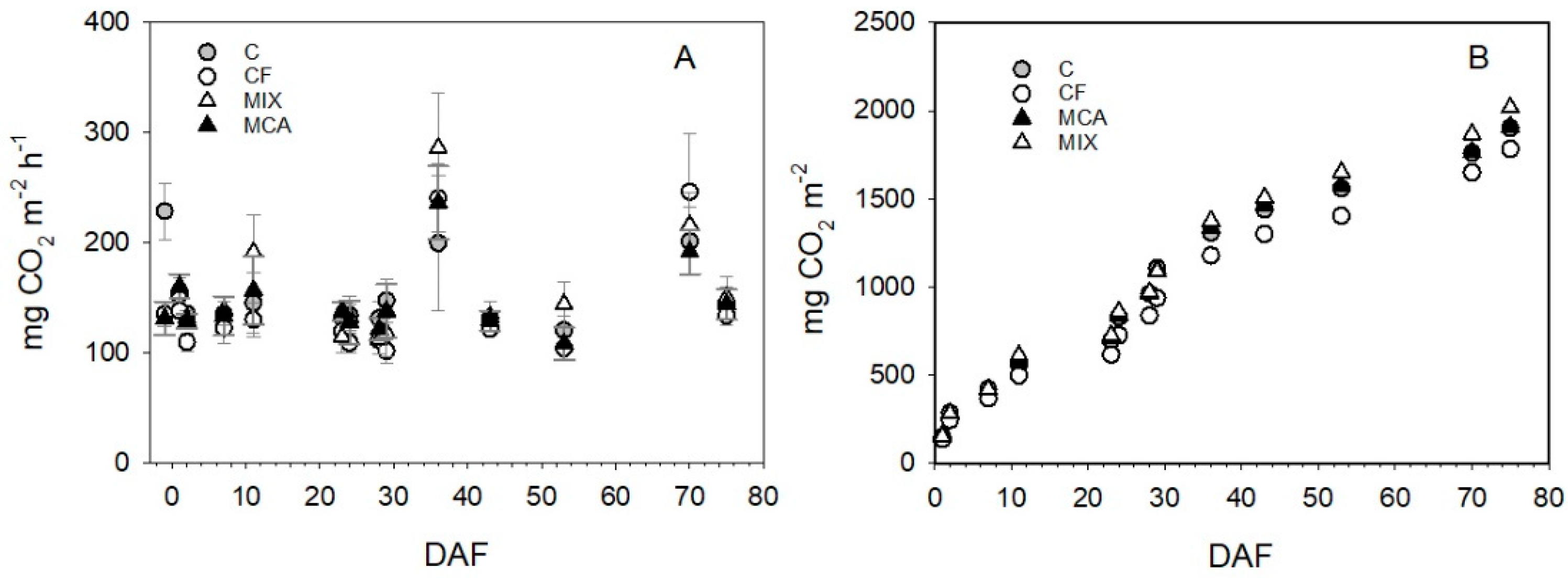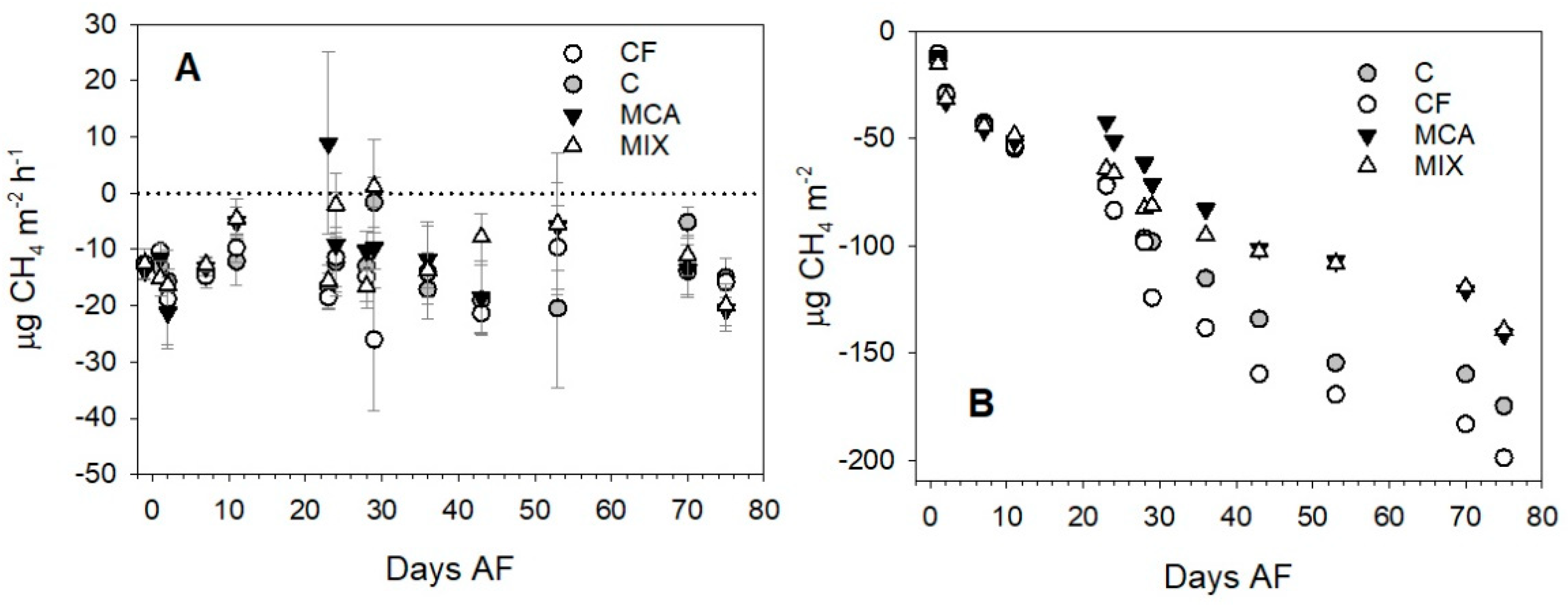Effect of Compost Derived from Urban Waste on Chard (Beta vulgaris L., var cycla) Yield and Soil GHG Fluxes in a Mediterranean Agricultural System
Abstract
:1. Introduction
2. Materials and Methods
2.1. Experimental Set Up and Location
2.2. Test Crop
2.3. Experimental Design and Soil Treatments
2.4. Field Sampling and Determination of GHG Soil-Atmosphere Exchange
2.5. Soil Available Mineral N and Plant Biomass Analyses
2.6. Statistical Analyses
3. Results
3.1. Effect of Fertilization on Crop Yield and Available Mineral N
3.2. Effect of Fertilization on GHG Soil-Atmosphere Exchange
4. Discussion
4.1. Effect of Treatments on Crop Yield and Mineral N
4.2. Effect of Treatments on Soil GHG Fluxes
4.3. Suggestions for Further Studies on MCA
5. Conclusions
Supplementary Materials
Author Contributions
Funding
Institutional Review Board Statement
Informed Consent Statement
Data Availability Statement
Conflicts of Interest
References
- Ciais, P.; Sabine, C.; Bala, G.; Bopp, L.; Brovkin, V.; Canadell, A.; Chhabra, R.; DeFries, R.; Galloway, J.; Heimann, C.; et al. Carbon and Other Biogeochemical Cycles BT. In Climate Change the Physical Science Basis. Contribution of Working Group I to the Fifth Assessment Report of the Intergovernmental Panel on Climate Change; Cambridge University Press: Cambridge, UK, 2009; pp. 465–570. [Google Scholar]
- Crippa, M.; Solazzo, E.; Guizzardi, D.; Monforti-Ferrario, F.; Tubiello, F.N.; Leip, A. Food systems are responsible for a third of global anthropogenic GHG emissions. Nat. Food 2021, 2, 198–209. [Google Scholar] [CrossRef]
- Nordahl, S.L.; Devkota, J.P.; Amirebrahimi, J.; Smith, S.; Breunig, H.M.; Preble, C.V.; Satchwell, A.J.; Jin, L.; Brown, N.J.; Kirchstetter, T.W.; et al. Life-Cycle Greenhouse Gas Emissions and Human Health Trade-Offs of Organic Waste Management Strategies. Environ. Sci. Technol. 2020, 54, 9200–9209. [Google Scholar] [CrossRef] [PubMed]
- Statista. Annual Greenhouse Gas Emissions in the European Union (EU-27) from 1990 to 2020, by Sector. Available online: https://www.statista.com/statistics/1171183/ghg-emissions-sector-european-union-eu/ (accessed on 12 November 2022).
- Aguilera, E.; Reyes-Palomo, C.; Díaz-Gaona, C.; Sanz-Cobena, A.; Smith, P.; García-Laureano, R.; Rodríguez-Estévez, V. Greenhouse gas emissions from Mediterranean agriculture: Evidence of unbalanced research efforts and knowledge gaps. Glob. Environ. Chang. 2021, 69, 102319. [Google Scholar] [CrossRef]
- Martínez-Blanco, J.; Lazcano, C.; Christensen, T.H.; Muñoz, P.; Rieradevall, J.; Møller, J.; Boldrin, A. Compost benefits for agriculture evaluated by life cycle assessment. A review. Agron. Sustain. Dev. 2013, 33, 721–732. [Google Scholar] [CrossRef] [Green Version]
- EEA. Bio-Waste in Europe Turning Challenges into Opportunities; Issue 04; Publications Office of the European Union: Luxembourg, 2020; ISBN 9789294802231. [Google Scholar]
- Anderson, N.; Snaith, R.; Madzharova, G.; Bonfait, J.; Doyle, L.; Godley, A.; Ming, L.; Fribourg-Blanc, B.; Sewage Sludge and the Circular Economy. EIONET Forum. 2021. Available online: https://forum.eionet.europa.eu/nrc-eionet-freshwater/library/urban-waste-water-treatment/sewage-sludge-and-circular-economy (accessed on 12 November 2022).
- Ferrentino, R.; Langone, M.; Mattioli, D.; Fiori, L.; Andreottola, G. Investigating the Enhancement in Biogas Production by Hydrothermal Carbonization of Organic Solid Waste and Digestate in an Inter-Stage Treatment Configuration. Processes 2022, 10, 777. [Google Scholar] [CrossRef]
- Raheem, A.; Sikarwar, V.S.; He, J.; Dastyar, W.; Dionysiou, D.D.; Wang, W.; Zhao, M. Opportunities and challenges in sustainable treatment and resource reuse of sewage sludge: A review. Chem. Eng. J. 2018, 337, 616–641. [Google Scholar] [CrossRef]
- Pasqualone, A.; Delvecchio, L.N.; Lacolla, G.; Piarulli, L.; Simeone, R.; Cucci, G. Effect of composted sewage sludge on durum wheat: Productivity, phenolic compounds, antioxidant activity, and technological quality. J. Food Agric. Environ. 2014, 12, 276–280. [Google Scholar]
- Pasqualone, A.; Summo, C.; Centomani, I.; Lacolla, G.; Caranfa, G.; Cucci, G. Effect of composted sewage sludge on morpho-physiological growth parameters, grain yield and selected functional compounds of barley. J. Sci. Food Agric. 2017, 97, 1502–1508. [Google Scholar] [CrossRef]
- Curci, M.; Lavecchia, A.; Cucci, G.; Lacolla, G.; De Corato, U.; Crecchio, C. Short-Term Effects of Sewage Sludge Compost Amendment on Semiarid Soil. Soil Syst. 2020, 4, 48. [Google Scholar] [CrossRef]
- Ding, A.; Zhang, R.; Ngo, H.; He, X.; Ma, J.; Nan, J.; Li, G. Life cycle assessment of sewage sludge treatment and disposal based on nutrient and energy recovery: A review. Sci. Total Environ. 2021, 769, 144451. [Google Scholar] [CrossRef]
- Fowler, D.; Coyle, M.; Skiba, U.; Sutton, M.A.; Cape, J.N.; Reis, S.; Sheppard, L.J.; Jenkins, A.; Grizzetti, B.; Galloway, N.; et al. The Global Nitrogen Cycle in the Twenty- First Century. Philos. Trans. R. Soc. B 2013, 368, 20130164. [Google Scholar] [CrossRef] [PubMed]
- IPCC. Application. In 2019 Refinement to the 2006 IPCC Guidelines for National Greenhouse Gas Inventories; IPCC: Geneva, Switzerland, 2019; pp. 1–48. ISBN 4887880324. [Google Scholar]
- Castaldi, S.; Alberti, G.; Bertolini, T.; Forte, A.; Miglietta, F.; Valentini, R.; Fierro, A. N2O Emission Factors for Italian Crops. In The Greenhouse Gas Balance of Italy, Environmental Science and Engineering; Valentini, R., Miglietta, F., Eds.; Springer: Berlin/Heidelberg, Germany, 2015; pp. 135–144. [Google Scholar]
- Lugato, E.; Zuliani, M.; Alberti, G.; Delle Vedove, G.; Gioli, B.; Miglietta, F.; Peressotti, A. Application of DNDC biogeochemistry model to estimate greenhouse gas emissions from Italian agricultural areas at high spatial resolution. Agr. Ecosyst. Environ. 2010, 139, 546–556. [Google Scholar] [CrossRef]
- Snyder, C.; Bruulsema, T.; Jensen, T.; Fixen, P. Review of greenhouse gas emissions from crop production systems and fertilizer management effects. Agric. Ecosyst. Environ. 2009, 133, 247–266. [Google Scholar] [CrossRef]
- Soil Survey Staff. Keys to Soil Taxonomy, 12th ed.; USDA-Natural Resources Conservation Service: Washington, DC, USA, 2014.
- IUSS Working Group WRB. World Reference Base for Soil Resources. In International Soil Classification System for Naming Soils and Creating Legends for Soil Maps; WRB: London, UK, 2014; Volume 106, p. 182. [Google Scholar]
- ISTAT. Istituto Nazionale Di Statistica, Italy. Agricoltura. 2022. Available online: https://www.istat.it/it/agricoltura?dati (accessed on 12 November 2022).
- Marinari, S.; Lagomarsino, A.; Moscatelli, M.C.; Di Tizio, A.; Campiglia, E. Soil carbon and nitrogen mineralization kinetics in organic and conventional three-year cropping systems. Soil Till. Res. 2010, 109, 161–168. [Google Scholar] [CrossRef]
- Stanford, G.; Smith, S.J. Nitrogen mineralization potentials of soils. Soil Sci. Soc. Am. Proc. 1972, 36, 465–472. [Google Scholar] [CrossRef]
- Castaldi, S.; Riondino, M.; Baronti, S.; Esposito, F.R.; Marzaioli, R.; Rutigliano, F.A.; Vaccari, F.P.; Miglietta, F. Impact of biochar application to a Mediterranean wheat crop on soil microbial activity and greenhouse gas fluxes. Chemosphere 2011, 85, 1464–1471. [Google Scholar] [CrossRef]
- Castaldi, S.; Bertolini, T.; Valente, A.; Chiti, T.; Valentini, R. Nitrous oxide emissions from soil of an African rain forest in Ghana. Biogeosciences 2013, 10, 4179–4187. [Google Scholar] [CrossRef] [Green Version]
- ISTAT. Istituto Nazionale di Statistica. 2021. Available online: http://dati.istat.it/Index.aspx?QueryId=33703 (accessed on 27 December 2021).
- Hargreaves, J.C.; Adl, M.S.; Warman, P.R. A review of the use of composted municipal solid waste in agriculture. Agric. Ecosyst. Environ. 2008, 123, 1–14. [Google Scholar] [CrossRef]
- Warman, P.R.; Rodd, A.V.; Hicklenton, P. The effect of MSW compost and fertilizer on ex-tractable soil elements and the growth of winter squash in Nova Scotia. Agr. Ecosyst. Environ. 2009, 133, 98–102. [Google Scholar] [CrossRef]
- Thangarajan, R.; Bolan, N.; Tian, G.; Naidu, R.; Kunhikrishnan, A. Role of organic amendment application on greenhouse gas emission from soil. Sci. Total Environ. 2013, 465, 72–96. [Google Scholar] [CrossRef]
- Firestone, M.K.; Davidson, E.A. Microbiological Basis of NO and N2O Production and Consumption in Soil. In Exchange of Trace Gases between Terrestrial Ecosystems and the Atmosphere; Andreae, M.O., Schimel, D.S., Eds.; Wiley: New York, NY, USA, 1989; pp. 7–21. [Google Scholar]
- Davidson, E.A. Fluxes of Nitrous Oxide and Nitric Oxide from Terrestrial Ecosystems. In Microbial Production and Consumption of Greenhouse Gases: Methane, Nitrogen Oxides and Halomethanes; Rogers, J.E., Whitman, W.B., Eds.; American Society for Microbiology: Washington, DC, USA, 1991; pp. 219–235. [Google Scholar]
- Castaldi, S.; De Grandcourt, A.; Rasile, A.; Skiba, U.; Valentini, R. CO2, CH4 and N2O fluxes from soil of a burned grassland in Central Africa. Biogeosciences 2010, 7, 3459–3471. [Google Scholar] [CrossRef]
- Groffman, P.M.; Butterbach-Bahl, K.; Fulweiler, R.W.; Gold, A.J.; Morse, J.L.; Stander, E.K.; Tague, C.; Tonitto, C.; Vidon, P. Incorporating Spatially and Temporally Explicit Phenomena (Hotspots and Hot Moments) in Denitrification Models. Biogeochemistry 2009, 93, 49–77. [Google Scholar] [CrossRef]
- Smith, K.A. Anaerobic Zones and Denitrification in Soil: Modelling and Measurements. In Denitrification in Soil and Sediment; Revsboech, N.P., Sørensen, J., Eds.; Plenum Press: New York, NY, USA, 1990; pp. 228–240. [Google Scholar]
- Verchot, L.V.; Davidson, E.A.; Cattânio, J.H.; Ackerman, I.L.; Erickson, H.E.; Keller, M. Land use change and biogeochemical controls of nitrogen oxide emissions from soils in eastern Amazonia. Glob. Biogeochem. Cycle 1999, 13, 31–46. [Google Scholar] [CrossRef]
- Chan, S.K.; Parkin, T.B. Methane oxidation and production activity in soils from natural and agricultural ecosystems. J. Environ. Qual. 2001, 30, 1896–1903. [Google Scholar] [CrossRef] [PubMed]
- Conrad, R. Soil Microbial Processes Involved in Production and Consumption of Atmospheric Trace Gases. In Advances in Microbial Ecology; Gwynfryn, J., Ed.; Plenum Press: New York, NY, USA, 1995; Volume 14, pp. 207–250. [Google Scholar]





| Description | Unit | Average Value (±1SD) | Italian Legislation Limit (D.lsg 75/10) |
|---|---|---|---|
| H | 6.7 ± 0.1 | 6≤ x ≤8.5 | |
| moisture | % | 21.8 ± 0.7 | ≤50 |
| ashes | % d.w. | 48.2 ± 1.2 | |
| organic C | % d.w. | 26.5 ± 2.6 | ≥20 |
| organic N | % d.w. | 2.3 ± 0.1 | |
| total N | % d.w | 2.6 ± 0.1 | |
| total P | % d.w | 1.0 ± 0.1 | |
| C/N | 11.7 | ≤25 | |
| humic and fulvic C | % d.w. | 16.7 ± 1.7 | ≥7 |
| salinity | dS/m | 3.2 ± 0.3 | |
| chrome VI | mg/kg d.w. | <0.01 | ≤0.5 |
| cadmium (Cd) | mg/kg d.w. | <0.001 | ≤1.5 |
| mercury (Hg) | mg/kg d.w. | <0.01 | ≤1.5 |
| nichel (Ni) | mg/kg d.w. | 7.8 ± 0.8 | ≤100 |
| lead (Pb) | mg/kg d.w. | 26.3 ± 2.1 | ≤140 |
| zinc (Zn) | mg/kg d.w. | 242.7 ± 12.1 | ≤500 |
| copper (Cu) | mg/kg d.w. | 139.1 ± 11.1 | ≤230 |
| Treatment | Control g d.w./m2 | CF g d.w./m2 | MCA g d.w./m2 | MIX g d.w./m2 |
|---|---|---|---|---|
| 1st Harvest | ||||
| Aboveground | 139.7 a ± 8.5 | 188.5 b ± 24.2 | 199.3 b ± 23.4 | 241.7 b ± 34.1 |
| Belowground | 24.3 a ± 2.1 | 32.1 b ± 3.7 | 32.4 b ± 3.8 | 40.6 b ± 5.3 |
| Total | 164.0 a ± 10.50 | 220.6 b ± 27.7 | 231.7 b ± 26.8 | 282.3 b ± 38.7 |
| 2nd Harvest | ||||
| Aboveground | 244.4 a ± 26.5 | 284.4 a ± 20.7 | 280.0 a ± 30.6 | 282.6 a ± 22.1 |
| Belowground | 71.6 a ± 8.8 | 78.2 a ± 5.1 | 100.8 b ± 11.6 | 77.9 a ± 8.4 |
| Total | 316.0 a ± 33.8 | 362.6 a ± 21.5 | 380.8 a ± 39.5 | 360.5 a ± 28.3 |
Disclaimer/Publisher’s Note: The statements, opinions and data contained in all publications are solely those of the individual author(s) and contributor(s) and not of MDPI and/or the editor(s). MDPI and/or the editor(s) disclaim responsibility for any injury to people or property resulting from any ideas, methods, instructions or products referred to in the content. |
© 2023 by the authors. Licensee MDPI, Basel, Switzerland. This article is an open access article distributed under the terms and conditions of the Creative Commons Attribution (CC BY) license (https://creativecommons.org/licenses/by/4.0/).
Share and Cite
Castaldi, S.; Bertolini, T.; Vannini, A.; Marinari, S.; Chilosi, G. Effect of Compost Derived from Urban Waste on Chard (Beta vulgaris L., var cycla) Yield and Soil GHG Fluxes in a Mediterranean Agricultural System. Atmosphere 2023, 14, 246. https://doi.org/10.3390/atmos14020246
Castaldi S, Bertolini T, Vannini A, Marinari S, Chilosi G. Effect of Compost Derived from Urban Waste on Chard (Beta vulgaris L., var cycla) Yield and Soil GHG Fluxes in a Mediterranean Agricultural System. Atmosphere. 2023; 14(2):246. https://doi.org/10.3390/atmos14020246
Chicago/Turabian StyleCastaldi, Simona, Teresa Bertolini, Andrea Vannini, Sara Marinari, and Gabriele Chilosi. 2023. "Effect of Compost Derived from Urban Waste on Chard (Beta vulgaris L., var cycla) Yield and Soil GHG Fluxes in a Mediterranean Agricultural System" Atmosphere 14, no. 2: 246. https://doi.org/10.3390/atmos14020246
APA StyleCastaldi, S., Bertolini, T., Vannini, A., Marinari, S., & Chilosi, G. (2023). Effect of Compost Derived from Urban Waste on Chard (Beta vulgaris L., var cycla) Yield and Soil GHG Fluxes in a Mediterranean Agricultural System. Atmosphere, 14(2), 246. https://doi.org/10.3390/atmos14020246









